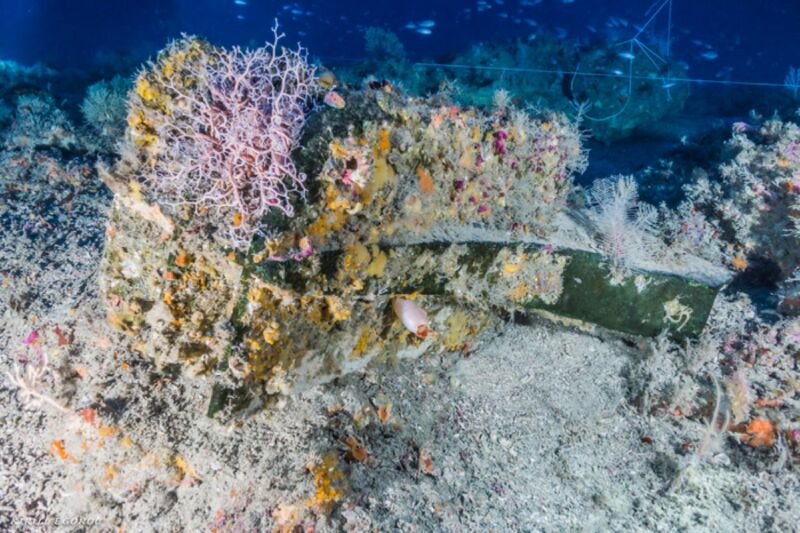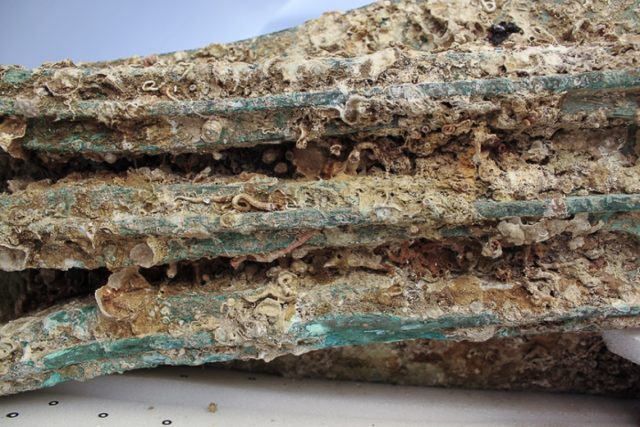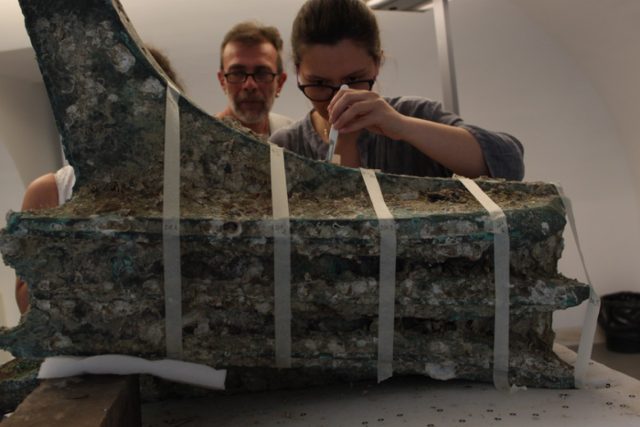The ship's ram as it was found on the seabed off Sicily at a depth of nearly 90 m, covered in marine life.
K. Egorov/SDSS-GUE
K. Egorov/SDSS-GUE
From Ars Technica by Jennifer Ouellette
Ship's ram from First Punic War serves as "ecological memory" of 2 millennia of underwater life.
Shipwrecks hold an enduring fascination, both because of how they connect us to the past and because of the potentially priceless treasures that could be lurking within their sunken remains.
Shipwrecks hold an enduring fascination, both because of how they connect us to the past and because of the potentially priceless treasures that could be lurking within their sunken remains.
They are also invaluable resources for scientists interested in studying how marine ecosystems evolve and thrive, since sea creatures inevitably colonize the wreckage, transforming destruction into life. In fact, more than 100 distinct animal species were found living on a 2,200-year-old Mediterranean shipwreck, according to a recent paperpublished in the journal Frontiers in Marine Science.
"Shipwrecks are often studied to follow colonization by marine organisms, but few studies have focused on ships that sank more than a century ago," said co-author Sandra Ricci of Rome's Istituto Centrale per il Restauro (ICR).
"Shipwrecks are often studied to follow colonization by marine organisms, but few studies have focused on ships that sank more than a century ago," said co-author Sandra Ricci of Rome's Istituto Centrale per il Restauro (ICR).
"Here we study for the first time colonization of a wreck over a period of more than 2,000 years. We show that the ram has ended up hosting a community very similar to the surrounding habitat, due to 'ecological connectivity'—free movement by species—between it and the surroundings."
Rome and Carthage were archrivals in the mid-3rd century BCE who fought three wars. The first war began in 264 BCE on and around the island of Sicily, and it dragged on for 23 years.
Rome and Carthage were archrivals in the mid-3rd century BCE who fought three wars. The first war began in 264 BCE on and around the island of Sicily, and it dragged on for 23 years.
Almost everything we know about the First Punic War comes from the writings of Greek historian-turned-Roman hostage Polybius, who wrote The Histories about a century after the First Punic War ended.
While there has been some debate about the accuracy of his accounts, most modern historians still rely heavily on Polybius, and his version of events is typically accepted when there are contradictions in other historical sources.
The war was ultimately decided at the Battle of the Aegates on March 10, 241 BCE.
The war was ultimately decided at the Battle of the Aegates on March 10, 241 BCE.
By this time, the Romans had gone nearly bankrupt maintaining a years-long blockade against the Carthaginians.
They had to borrow the funds to build a fleet to extend their blockade to the last of the Carthaginian strongholds.
Although the Carthaginian fleet was larger, the Romans were better trained and emerged victorious.
The Carthaginians signed the Treaty of Lutatius, ceding control of Sicily to Rome and even paying reparations.
Enlarge / Close-up of the ship's ram and the marine animals on it.
Istituto Centrale per il Restauro (ICR)
Istituto Centrale per il Restauro (ICR)
Several artifacts believed to be from this battle have been recovered from off the coast of Western Sicily since 2010.
For instance, archaeologists have found 11 bronze rams from sunken warships.
These thrusting weapons were fitted to the bow of ancient galleys and designed to break through the hull framing of enemy ships.
Archaeologists have also found 10 bronze helmets and several hundred amphorae.
All the rams, seven of the helmets, and six complete amphorae have since been recovered (the rest are still on the seabed).
Based on inscriptions, archaeologists determined that four rams came from Roman ships, while one came from a Carthaginian ship—all most likely triremes, based on their dimensions.
The ship's ram that became a dream home for so many marine creatures was recovered in 2017. Because it has been on the ocean floor for more than 2,000 years, the ram had a long time to become part of a stable marine ecosystem.
The ship's ram that became a dream home for so many marine creatures was recovered in 2017. Because it has been on the ocean floor for more than 2,000 years, the ram had a long time to become part of a stable marine ecosystem.
"The ram has trapped mineral structures and fragments (i.e., tubes and shells) of species living in the surrounding habitats transported by bottom current," the authors wrote.
"Therefore, together with its inestimable value as an archaeological artifact, the ram... highlights the dynamics of biological colonization on a large spatial scale and serves as a relevant proxy for the study of marine biodiversity."
Dubbed Egadi 13, the ram was restored in 2019.
During that process, ICR scientists carefully sampled and documented all the sediment blocks and biological materials that had accumulated both inside and outside the hollow artifact.
The samples were carefully cleaned to remove sediment, dried, and sieved before being examined under a microscope.
Any biological fragmented remains were carefully preserved in Petri dishes for analysis.
Enlarge / Researchers sampling marine animals from the ship's bronze ram.
Istituto Centrale per il Restauro (ICR)
The researchers were able to identify 114 different invertebrate species that had made the 2,200-year-old ram their home, including 33 gastropod species, 25 species of bivalve mollusks, 33 species of polychaete worms, and 23 species of bryozoans.
They compared those findings to species found naturally in Mediterranean habitats in hopes of learning more about how the ram had been colonized.
"We deduce that the primary 'constructors' in this community are organisms such as polychaetes, bryozoans, and a few species of bivalves.
Their tubes, valves, and colonies attach themselves directly to the wreck's surface," said co-author Edoardo Casoli from Rome's Sapienza University.
"Other species, especially bryozoans, act as 'binders': their colonies form bridges between the calcareous structures produced by the constructors. Then there are 'dwellers', which aren't attached but move freely between cavities in the superstructure. What we don't yet know exactly is the order in which these organisms colonize wrecks."
"Younger shipwrecks typically host a less diverse community than their environment, with mainly species with a long larval stage which can disperse far," said co-author Maria Flavia Gravina, a biologist with the University of Rome and the National Interuniversity Consortium for Marine Science.
"By comparison, our ram is much more representative of the natural habitat: it hosted a diverse community, including species with long and short larval stages, with sexual and asexual reproduction, and with sessile and motile adults, who live in colonies or solitary. We have thus shown that very old shipwrecks such as our ram can act as a novel kind of sampling tool for scientists, which effectively act as an 'ecological memory' of colonization."



No comments:
Post a Comment